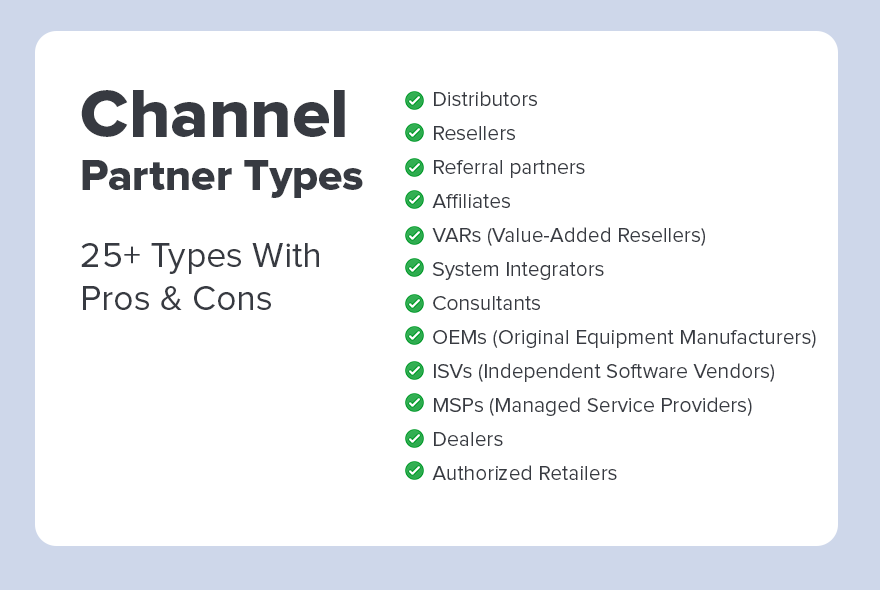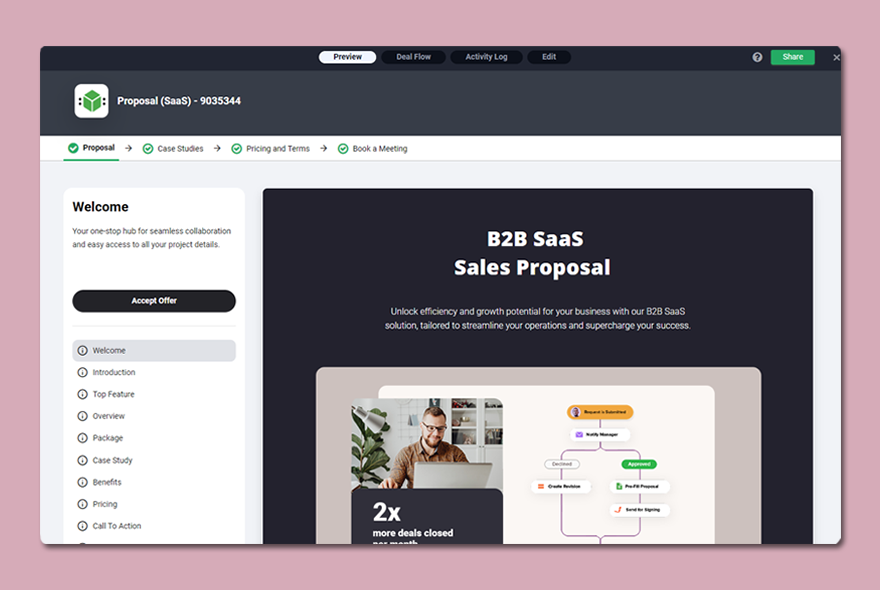Table of Contents
What is a Partner Enablement?
Partner enablement is the process of providing partners with the tools, resources, training, and support they need to effectively sell and service a product. This helps them to be more successful and profitable in their partnership with a company.
What does partner enablement include?
- Comprehensive training programs
- Sales and marketing tools
- Regular product updates
- Technical support resources
- Access to analytics and performance monitoring
- Communication platforms
- Incentive and reward systems
- Collaboration opportunities
- Legal and compliance guidelines
Why Do You Need a Partner Enablement Strategy?
The primary goal of partner enablement is to help your business drive more revenue. It allows you to make the most of the resources you already have.
Well-organized sales materials will help your partners close more deals and tap into new revenue streams. Partner enablement involves organizing and revising marketing, sales and onboarding materials. This approach also helps you expand your market presence more effectively, ensuring that potential profits aren’t missed.
This strategic approach supports your business in growing steadily and reaching more customers through your partners.
A good partner enablement strategy typically results in:
- Increased Sales: Partners are better equipped to sell products effectively, leading to higher sales volumes.
- Improved Partner Performance: With the right training and resources, partners can optimize their operations and improve their overall performance.
- Enhanced Product Knowledge: Partners gain a deeper understanding of the products, which enables them to address customer needs more accurately and enhance customer satisfaction.
- Stronger Partner Relationships: Effective enablement fosters trust and loyalty among partners, strengthening the business relationship.
- Greater Market Reach: Well-supported partners can expand their activities into new markets, increasing the brand’s overall market presence.
- Higher Partner Retention: When partners feel supported and successful, they are more likely to continue their business relationship.
- Better Customer Satisfaction: Well-informed and capable partners lead to happier customers, thanks to better service and support.
How to Create a Winning Partner Enablement Strategy?
Before you begin implementing any partner enablement strategy, it’s essential to first conduct a comprehensive partner needs assessment. This assessment helps you understand the specific resources, training, and support that your partners need to be successful.
To truly understand your partners, consider stepping into their shoes for a day. This approach allows you to experience their daily workflow firsthand.
What are the key questions?
- How and where do my partners sell?
- What do my partners need to sell my product or service?
- What is the hardest part of the training program for partners?
- What is the hardest part of the sales process for partners?
- What can I exclude from my program to reduce complexity?
- What are the most frequent questions from partners?
- Is this type of partner the best for my business? (List of partner types)
- How much time do I spend enabling new partners versus existing partners?
Get Partner Onboarding Process Template Today!
Tackle common challenges in channel partner onboarding process such as engagement, training consistency, and effective communication to enhance partner relationships and boost collaboration.
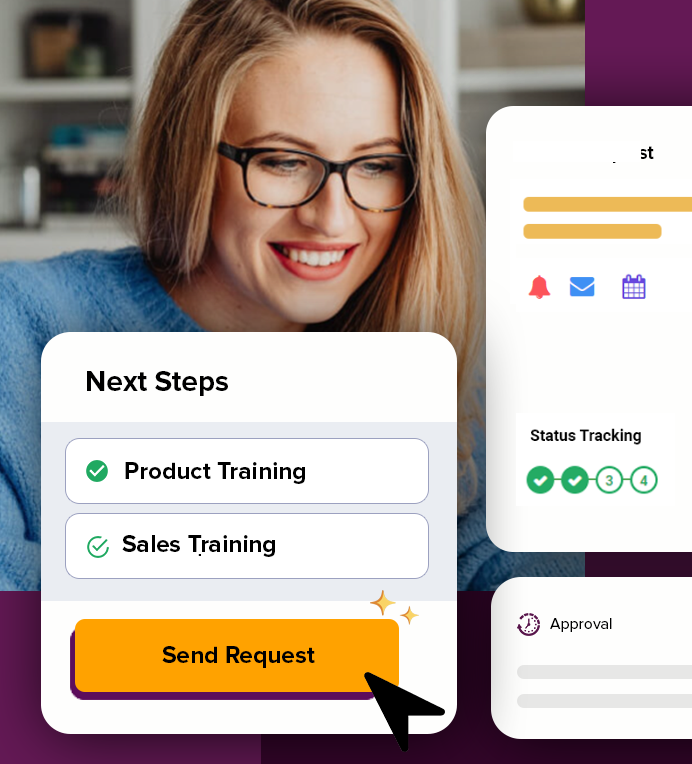
Learn From Previous Partnerships
When looking to improve your partnerships, a good start is to analyze the performance statistics of your past and current partners.
Identify where the most significant drops in performance occur. Is there a trend or pattern that points to specific weaknesses in training or educational materials?
Understanding these patterns can be pivotal. Consider whether the performance dips are seasonal. Some products or services naturally have seasonal demand, and recognizing these patterns can help in planning better support during low seasons.
Evaluate if your current training and education materials are sufficient. Perhaps the drops in performance are due to gaps in these areas. Providing additional or improved resources could help partners overcome these obstacles.
TIP: Consider direct engagement with your partners to discuss these findings. They can provide first-hand insights into what challenges they are facing and what support they need. This kind of collaborative approach not only helps in addressing the immediate issues but also strengthens the relationship with your partners.
Give Structure To Partner Operations
Organizing your channel partner operations effectively includes several key activities: recruiting, onboarding, tracking leads, registering deals, sharing content, and managing communication channels.
Organizing Partner Onboarding Process Into Phases
To bring consistency to these processes, consider using a platform like DocsCube. Partner portals can help you establish standardized procedures for onboarding new partners.
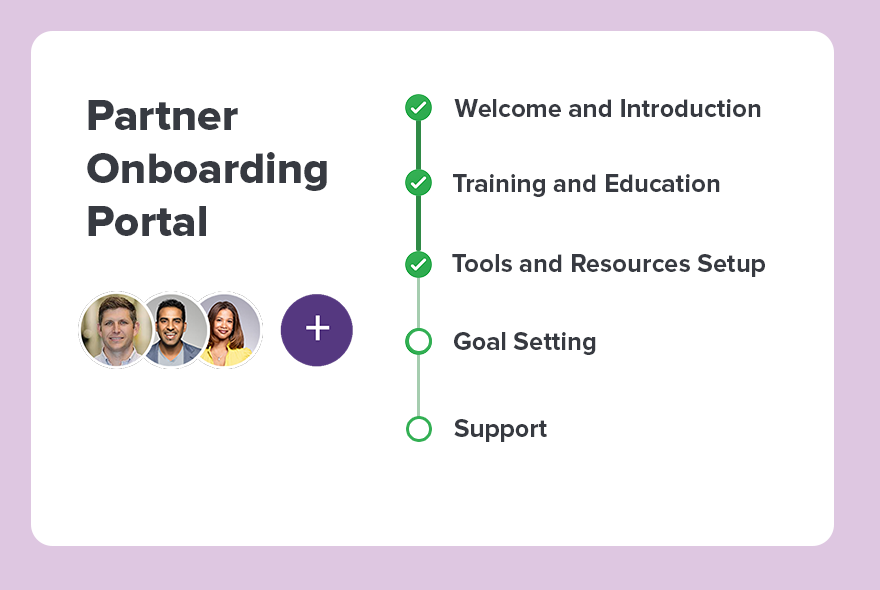
Here are some key areas of partner operations that can be standardized:
- Recruiting Process: Define consistent criteria and steps for selecting new partners.
- Onboarding Process: Create a uniform checklist and timeline for introducing new partners to your business.
- Training Process: Develop standardized training sessions that all partners must complete.
- Content Sharing: Set guidelines for how and when partners can use and share marketing and sales content.
- Communication Channels: Designate specific tools and platforms for regular communication between your company and its partners.
- Feedback Mechanisms: Implement a structured process for partners to provide feedback on products, support, and collaboration effectiveness.
How To Ensure Partner’s Engagement? Motivation is The Key
Motivating channel partners is essential for maintaining a vibrant, productive partnership.
TIP: Remember, monetary rewards aren’t always the primary motivator for everyone. Building strong, trusting relationships with your channel partners can often be the deciding factor in their commitment and enthusiasm. When partners feel genuinely valued and supported, they are more likely to invest in promoting your products and services.
Here are effective strategies for keeping channel partners engaged:
Regular Incentives and Promotions: Periodic incentives can spur short-term efforts and help maintain interest and excitement around selling your products. These might include limited-time bonuses, contests, or spiffs (immediate bonuses for sales).
Recognition and Rewards: Recognize and publicly celebrate the achievements of top-performing partners. Acknowledgment in front of their peers can be a powerful motivator and can drive a healthy competitive environment.
Provision of Sales and Marketing Tools: Equip your partners with high-quality, effective sales and marketing materials that can make their efforts more productive. This includes brochures, product datasheets, online content, and more.
Support: Ensure that partners have easy access to support when they need it. This can range from technical support for products to administrative assistance in deal registration. Quick and reliable support boosts partner confidence and effectiveness.
Partnership and Trust Building: Foster a culture of trust and partnership. When partners feel they are a valued part of a team and their input is respected, their commitment to the brand deepens.
Speed Up Onboarding Processes
Simplified and clear partner onboarding processes help reduce the time to productivity. It’s beneficial to use a phased approach, starting with basic product knowledge and gradually moving to more complex sales strategies and support.
Get ready-to-use partner onboarding process template.
Use Checklists
Develop comprehensive checklists that cover all necessary steps in the onboarding process. Partner onboarding checklists can include items like sending welcome packages, completing necessary paperwork, undergoing initial training sessions, setting up account access, and understanding product portfolios.
Establish Clear Timelines
In a partner portal you can create tasks and provide clear deadlines for each step of the onboarding process. This helps manage expectations and keeps the process moving forward. Timelines also assist partners in planning their activities and allocating the right resources at the right times.
Define Clear Milestones
Set specific milestones within the onboarding process that partners need to achieve before moving to the next phase. Milestones could be related to training completion, first sales achievements, or successful integration of IT systems. These milestones help gauge progress and provide opportunities for early intervention if partners are not meeting expectations.
A real-life tip for enhancing partner productivity is to set specific, achievable goals for each week or even each day. Make these milestones simple and realistic. This will help you engage partners from the start.
Improve Training Tactics
The goal is for partners to leave the training not only understanding the product inside and out but also feeling capable and motivated to effectively engage with customers and drive sales.
Effective training should result in partners who are well-informed about your products and confident in their ability to sell and support them.
Providing a partner program template can be very helpful by offering a clearer view of the project, resources, and timeline.
Here are several strategies to enhance the training process:
Establish Clear Learning Paths
Define clear learning paths that guide partners through the initial training and ongoing learning. These paths should include milestones and checkpoints to assess understanding and progress.
Leverage Multiple Learning Formats
People learn in different ways, so incorporate a variety of formats such as video tutorials, interactive webinars, live workshops, and written guides. This variety caters to different learning preferences and can help reinforce key concepts.
Reward Completion and Certification
Motivate partners by recognizing and rewarding their training achievements. Certificates, badges, or incentives for completing training modules can boost motivation and encourage ongoing learning.
What Can I Do After Training to Help Partners?
After the formal training sessions are completed, there are several effective actions you can take to continue supporting your partners and help them succeed.
Here’s how you can extend your support beyond initial training:
- Provide Ongoing Support: Offer continuous access to learning materials, updates on products and industry trends, and refresher courses. This keeps the partner informed and up-to-date, which is essential for maintaining their confidence and competence.
- Establish Regular Check-Ins: Schedule regular meetings or calls with partners to discuss their progress, challenges, and needs. This helps in identifying any areas where they might require additional support and demonstrates your commitment to their success.
- Offer Marketing and Sales Support: Provide partners with marketing and sales tools that can help them generate leads and close sales. This could include access to automated marketing software, customizable campaign materials, or analytics tools that help them target the right customers.
- Recognize and Reward Success: Implement a recognition and rewards program to celebrate partners who achieve their goals or perform exceptionally. Recognizing their efforts not only motivates the successful partners but also encourages others to strive for similar success.
- Monitor Partner Performance: Keep track of key performance indicators to gauge how well partners are applying their training in real-world scenarios. Offer targeted support where the data shows it’s needed, helping partners to overcome specific obstacles and improve their performance.
- Ensure Access to Technical Support: Ensure that partners have easy and prompt access to technical support for the products or services they are selling. Quick resolution of technical issues is crucial for maintaining customer satisfaction and trust.
- Implement a Feedback Loop: Encourage and facilitate regular feedback from partners regarding the training they received and the ongoing support they need. Use this feedback to continuously improve your training programs and support services.
TIP: Pair new partners with experienced ones. A mentorship program can provide newcomers with practical advice and insights that only come from experience, helping them navigate complex sales scenarios or operational challenges more effectively.
Create & Share List Of Sales and Marketing Collateral
Providing partners with easy access to a diverse range of materials aims to empower them to engage with customers confidently, address their needs effectively, and ultimately drive sales growth.
This initiative enhances the partner experience, fosters collaboration between our team and partners, and ensures consistent messaging and branding across all marketing channels.
Monitor Usage and Gather Feedback: Track which materials are used most and least frequently and gather feedback from partners on the usefulness of each item. This feedback can be instrumental in determining what types of collateral are most effective and which may need to be improved or replaced.
Deliver Right Information At the Right Time
Overwhelming partners with too much material during the initial phase can lead to confusion and hinder their performance.
Strategically pacing the distribution of information and resources ensures that partners can effectively absorb and apply their new knowledge, setting the stage for optimal performance and success.
This involves understanding the specific needs and timelines of your audience and ensuring that they receive relevant and timely updates that support their decision-making and operational processes.
Key Strategies
- Understand Your Partners: Gather insights on the preferences and challenges of your partners. This helps tailor the information delivery to their specific needs.
- Segment Your Information: Break down the information into manageable and relevant segments. This makes it easier for recipients to digest and apply the information effectively.
- Use Automated Tools: Leverage partner portals to schedule and deliver information at optimal times. These tools can be set up to send reminders, updates, and educational content based on predefined schedules or triggers.
- Monitor Feedback and Adjust: Regularly collect feedback on the usefulness and timing of the information provided. Use this feedback to fine-tune how and when you communicate, ensuring maximum relevance and impact.
- Anticipate the Needs: Anticipate the needs of your partners or customers based on their business cycles, product usage patterns, or external factors like market changes. Proactively providing them with information before a critical decision point can significantly enhance their efficiency and decision quality.
Technology Tools
Leveraging technology tools efficiently is vital to enhancing the management of partner operations in 2024 and ensuring a seamless Partner Experience (PX).
On the other hand, using multiple tools overcomplicates processes and adds unnecessary complexity to your partnership management.
Create a Partner Portal
Setting up a dedicated partner portal offers a central location where partners can access all necessary resources. This allows partners to easily find marketing materials, training videos, and product updates.
It can also provide tools for tracking sales performance, registering deals, and accessing support services. Offering a comprehensive and user-friendly portal enables partners to manage their activities effectively, improving their ability to succeed and grow within your partnership program.
Enabling New Partners vs Existing Partners
When a company is growing, the strategy for allocating resources between new and existing partners becomes more important.
New partner enablement focuses primarily on onboarding and initial training to bring them up to speed with the product portfolio, sales techniques, and market positioning. This phase is critical as it sets the foundation for the partner’s future performance and alignment with your brand.
As a general rule, more intensive resources should be allocated to new partners initially. This includes comprehensive training sessions, step-by-step guides, and high-touch support during the early stages of their journey.
For existing partners, the focus shifts towards deepening their product knowledge, optimizing sales techniques, and fostering loyalty. This segment requires continuous education and support to keep them updated and motivated.
Existing partners typically need less intensive day-to-day support but benefit significantly from advanced training and periodic updates. Allocating resources for advanced certifications, market trend updates, and new product features is crucial.
Latest Trends and Research Data: Recent studies highlight the importance of continuous investment in existing partners. Data indicates that partners who receive ongoing training and resources are more likely to increase their sales volumes by up to 29% compared to those who only receive initial onboarding.
Keep It Stupid Simple (KISS)
Simplifying the onboarding process is important because it helps new partners quickly understand your business model, products, and the tools they need to succeed.
How to simplify partner enablement:
- Streamline Documentation
- Automate Processes
- Focus on Key Objectives
- Use Visual Aids
- Regular Feedback Loops
Offer Marketing Development Funds (MDF)
Offering Marketing Development Funds (MDF) can be highly beneficial for partner enablement, providing a direct financial incentive that helps partners increase their marketing efforts and drive sales.
Investing in partners’ marketing efforts can significantly boost selling capabilities, ultimately leading to a higher return on investment through increased sales.
Here are some key benefits of MDF implementation
- Encourages Marketing Activities
- Supports Customized Marketing
- Strengthens Partnership Bonds
- Drives Results and Accountability:
- Enhances Return on Investment
From Good to Great
Transitioning from good to great in partner enablement involves refining your approach and implementing best practices that foster deeper engagement and higher productivity among your channel partners.
Here are some real-life advice for achieving excellence in partner enablement:
- Personalize Partner Experiences
- Enhance Training Programs
- Regularly Update and Refresh Content
- Foster a Community of Partners
- Establish Clear Communication Channels:
- Measure and Reward Success
- Provide Executive Sponsorship
- Invest in Partner Success Managers
Scaling & Growth
While initial efforts may focus on establishing foundational relationships and processes, scaling requires a broader and more robust approach to accommodate increased demand and complexity.
To prepare for scaling a partner program, several key activities must be undertaken:
- Enhance Infrastructure: Strengthen the technical and administrative infrastructure to handle a larger volume of partners and transactions without performance degradation.
- Standardize Processes: Develop and implement standardized processes that can be easily replicated and maintained across an expanding network of partners.
- Invest in Training: Scale up training resources and modalities to ensure that as the number of partners grows, each one receives the information and support needed to succeed.
- Automate Systems: Increase the use of automation in areas like reporting, communications, and management tasks to reduce the workload on human resources and minimize errors.
- Expand Support Teams: Grow the support team to maintain a high level of service for a larger network of partners, ensuring all partners receive the timely assistance they need.
- Data Management and Analytics: Enhance capabilities in data management and analytics to effectively track performance across a larger scale and use insights to drive strategic decisions.
When scaling a partner program, pricing strategies often need to be adjusted to accommodate the changes and demands of a growing network.
Here’s how pricing might evolve:
- Volume Discounts: As the scale of a partner program increases, offering volume discounts becomes feasible and can encourage larger purchases or commitments from partners.
- Tiered Pricing Models: Implementing tiered pricing based on the level of engagement or achievement within the program can be effective. Partners who reach higher tiers by surpassing certain thresholds can access better prices, which not only boosts motivation but also rewards top performers.
- Flexible Pricing Options: As the program grows, providing more flexible pricing options can accommodate a wider range of partners with different capabilities and market reach.
- Cost Reductions: Increased scale can lead to reduced costs per unit or operation due to economies of scale.
- Performance-Based Incentives: Introducing or expanding performance-based pricing incentives can be an effective strategy. Partners who demonstrate high performance and contribute significantly to revenue might receive special pricing or rebates, enhancing their profitability.
- Regular Price Reviews: With growth, it’s crucial to continuously review and adjust pricing strategies based on market feedback, competitive dynamics, and cost structures. Regular reviews ensure that the pricing remains relevant and competitive.
Navigating Challenges
Here are some real-life examples of challenges that can occur during partner enablement programs:
Misalignment of Goals: Sometimes, the objectives of the organization and its partners can diverge, leading to conflicts over priorities or resource allocation. This misalignment can make it difficult to achieve collective targets.
TIP: Regularly hold alignment meetings to ensure that both parties understand and agree on objectives. Use these sessions to realign goals and expectations as needed.
Inconsistent Communication: Effective communication is crucial, but partners often face challenges due to differing time zones, language barriers, or unclear communication channels, leading to misunderstandings and delays.
TIP: Establish clear communication protocols and use collaborative tools that support real-time sharing and updates. Offer multilingual support if necessary to bridge language barriers.
Varied Skill Levels: Partners come with varying levels of expertise and experience. Providing training that is too basic or too advanced can lead to frustration and disengagement among partners.
TIP: Develop a tiered training program that accommodates different levels of expertise. Offer foundational courses for beginners and advanced modules for more experienced partners.
Technology Adoption: Introducing new tools or platforms requires partners to adapt to new technologies. Resistance to change or technical difficulties can hinder the effective use of these tools.
TIP: Provide comprehensive training and support for new technologies. Consider incentives for early adopters or success stories that highlight the benefits of embracing new tools.
Scalability Issues: As the program grows, scaling the enablement processes without losing the quality of training and support becomes a significant challenge.
TIP: Plan for scalability from the start by designing processes that are easily replicable and can be automated. Regularly review systems and processes to ensure they can handle increased loads.
Channel Partner Software
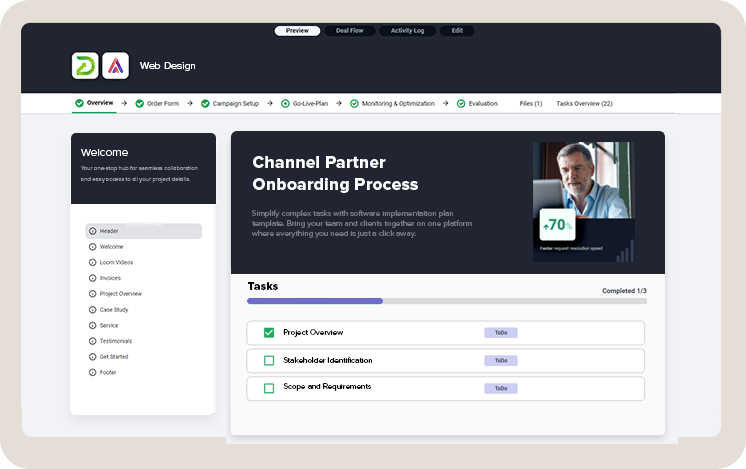
How can partner portals help?
Separate Onboarding in Phases
Organizing the onboarding process into distinct phases allows for a more manageable and structured introduction for new partners. Each phase can focus on different aspects of the partnership, such as initial introduction to the product line, sales and marketing strategies, and advanced technical support.
Set Tasks, Reminders, and Milestones
Incorporating task management features into the partner portal ensures that both the partners and the managing team can keep track of required activities and deadlines. Setting tasks, reminders, and milestones helps partners stay organized and progress through their onboarding and ongoing engagement with clear objectives.
Onboarding Flow Visualization
Visual tools such as flowcharts or process diagrams within the portal can greatly aid partners in understanding the steps involved in the onboarding process and their journey as a partner.
Onboarding flow visualization provides a clear roadmap of what is expected at each stage of the partnership and what steps they need to take next, reducing confusion and enhancing partner experience.
Future Trends
These trends indicate a dynamic evolution in the field of partner enablement, where technology, personalization, and strategic collaboration will drive future initiatives.
Organizations that adapt to these changes and invest in the relevant technologies and strategies will likely see enhanced partner performance and greater business success.
Here are some notable trends to watch:
Increased Use of Automation and AI
Automation and artificial intelligence (AI) are increasingly important in improving partner enablement. They help by automating routine tasks and providing insights for smarter decisions, which cuts costs and boosts efficiency.
Studies show that companies using AI in sales and marketing see up to a 30% increase in leads and a 25% better rate of closing deals.
Greater Emphasis on Personalization
Data-driven personalization strategies are expected to improve partner engagement and performance, with studies showing that personalized programs can boost partner productivity by over 15%.
Expansion of Remote Learning Platforms
The shift towards remote work has accelerated the adoption of digital and remote learning platforms for partner training. These platforms offer flexibility and accessibility, enabling partners to engage in training programs from anywhere, anytime.
Enhanced Analytics and Performance Tracking
Advanced analytics will play a crucial role in measuring and enhancing partner performance. Real-time data analytics help organizations track partner activities and outcomes more effectively, leading to better-informed strategies and interventions.
Unlock the Power of Your Channel Partners
In conclusion, unlocking the full potential of your channel partners through partner enablement strategy is essential for thriving in 2024.
By implementing effective strategies and utilizing the right software, you can ensure that your partners are well-prepared, motivated, and aligned with your business goals.
DocsCube Portals offer a streamlined solution to standardize the onboarding process, making it simpler and more consistent. This improves their ability to succeed in a competitive market. Embrace these tools and strategies to transform your channel partners into powerful assets for your business, driving growth and achieving substantial results in the coming years.
Set Up Your Partner Onboarding Process in Just a Few Minutes!
Boost your sales with our easy-to-use partner onboarding software. Bring your team and channel partners together on one platform where everything they need is just a click away.

